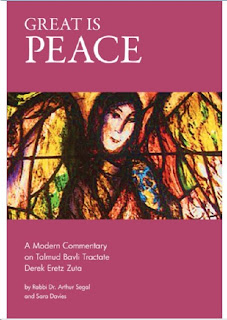RABBI ARTHUR SEGAL: JEWISH RENEWAL: DEREK ERETZ: GREAT IS PEACE
INTERPRETATION OF SCRIPTURES DIFFERS AMONG PRACTITIONERS
Shalom and Peace:
Today we continue with a bit more of Jewish Ethics (Derek Eretz 1:4 )
''Do not discuss with the Sadducees, so that you shall not fall into the Gehenna.''
What is Gehenna? We might answer that Gehenna is Hell, but because Judaism teaches that all of Israel has a share in the World to Come (as do the righteous of all nations and religions), Gehenna is, at most, a 12-month boot camp for the soul (Sanhedrin Ch.11). Those who rid themselves of character defects while still alive will run fewer spiritual laps in Gehenna. Those who don't, will wear out a pair of Nikes each week.
Who are the Sadducees, and what is wrong with talking to them? The term Sadducees is derived from the name of Zadok, the first High Priest of Solomon's Temple (ca. 950 BCE.)
Sadducees practiced the religion of Hebraism. Hebraism accepts only the Five Books of Moses; it discards the Prophetic texts as well as the Rabbinic texts (including the Talmud.) The Hebrews did not believe in corporeal resurrection, in an afterlife, or in a messiah. They did believe in a cult God who punishes, but this was not the universal God of Judaism. The Sadducees didn't believe in direct prayer to God, but in the intercession of the priesthood through animal and grain sacrifices.
When the Temple was destroyed in 586 BCE, the two remaining Hebrew tribes, Judah and Benjamin, were captured and taken to Babylon. They could no longer worship as Hebrews. Over time, Talmudic rabbinic Judaism emerged. And this split, this separation, labeled them Pharisees. The word pharisees comes from Hebrew, and means 'to separate.'
For as long as the rabbis were in what we now call Iraq and Iran, and the Hebraists, with their Temple by Ezra, remained in what we today call Israel, the two religions didn't clash very much. After the Hashmonian-Maccabean revolt (ca. 165 BCE), both groups became prominent in various parts of Israel.
To say they didn't get along is an understatement. The rabbis say: "A learned mamzer [bastard] takes precedence over an ignorant High Priest" (Horayot 3:8). They agreed on very little. For example, the Pharisaic-Rabbinic understanding of "an eye in place of an eye" was that the value of an eye was to be paid by the perpetrator (Bava Kamma, Ch. 8). The Sadducees interpreted the phrase literally: the offender's eye would be removed.
We will continue with this verse next month.
Rabbi Arthur Segal is an international lecturer, author, and teacher. Visit him at www.JewishSpiritualRenewal.org . Follow him on FaceBook at 'Arthur L Segal', on Twitter at RabbiASegal, or his blog at http://rabbiarthursegal.blogspot.com . Email at RabbiASegal@aol.com .
Jewish Renewal www.jewishrenewal.info
Jewish Spiritual Renewal http://rabbiarthursegal.blogspot.com
Jewish Spirituality
Eco Judaism
facebook.com/RabbiArthurSegalJewishSpiritualRenewal
Hilton Head Island, SC, Bluffton, SC, Savannah, GA
| © 2012 Rabbi Arthur Segal Jewish Spiritual Renewal |
Jewish Renewal www.jewishrenewal.info
Jewish Spiritual Renewal http://rabbiarthursegal.blogspot.com
Jewish Spirituality
Eco Judaism
facebook.com/RabbiArthurSegalJewishSpiritualRenewal
Hilton Head Island, SC, Bluffton, SC, Savannah, GA




